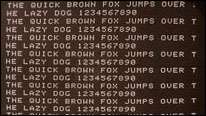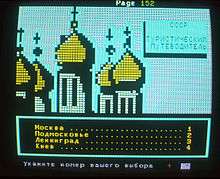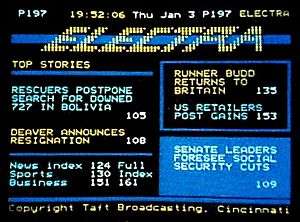Teletext systems
Teletext (or "broadcast teletext") is a television information retrieval service developed in the United Kingdom in the early 1970s. It offers a range of text-based information, typically including national, international and sporting news, weather and TV schedules. Subtitle (or closed captioning) information is also transmitted in the teletext signal, typically on page 888[1] or 777.
- This is a sub-article to Teletext.
A number of similar teletext services were developed in other countries, some of which attempted to address the limitations of the British-developed system, with its simple graphics and fixed page sizes.
UK: Teletext
Teletext was created in the United Kingdom in the early 1970s. Different systems existed, but by the end of the decade they converged, with the creation of the World System Teletext (WST). WST remained in use for analogue broadcasts until 2012.
Early tests
Ceefax

The first test transmissions were made by the BBC in 1972–74, with the name Ceefax ("see facts"). The Ceefax system went live on 23 September 1974 with thirty pages of information. Due to the adoption of a common teletext standard (WST), the Ceefax system ceased in 1976. The name was retained for the service itself, that continued after that year using the WST standard.
Oracle
ORACLE was first broadcast on the ITV network in the mid-late 1970s. Due to the adoption of a common teletext standard (WST), the ORACLE system ceased in 1976. The name was retained for the service itself, that continued after that year using the WST standard.
World System Teletext
World System Teletext (or WST) is the name of a standard for teletext throughout Europe today. Almost all television sets sold in Europe since the early ’80s have built-in WST-standard teletext decoders as a feature.
It originally stems from the UK standards developed by the BBC (Ceefax) and the UK Independent Broadcasting Authority (ORACLE) in 1974 for teletext transmission, extended in 1976 as the Broadcast Teletext Specification.
With some tweaks to allow for alternative national character sets, and adaptations to the NTSC 525-line system as necessary, this was then promoted internationally as "World System Teletext".
It was accepted by CCIR in 1986 as CCIR Teletext System B, one of four recognised standards for teletext worldwide.
France: Antiope

In France, where the SECAM standard is used in television broadcasting, a teletext system was developed in the late 1970s under the name Antiope. It had a higher data rate and was capable of dynamic page sizes, allowing more sophisticated graphics. It was phased out in favour of standard teletext in 1991.
Canada: Telidon
The CBC ran a teletext service, IRIS, accessible only in Calgary, Toronto and Montreal. It ran from 1983 until about 1986, and used the Canadian-developed Telidon system, which was developed in 1980. Like Antiope, Telidon allowed significantly higher graphic resolution than standard teletext.
United States
Adoption in the United States was hampered due to a lack of a single teletext standard and consumer resistance to the high initial price of teletext decoders. Throughout the period of analogue broadcasting, teletext or other similar technologies in the US were practically non-existent, with the only technologies resembling such existing in the country being closed captioning, TV Guide On Screen, and Extended Data Services (XDS).
Early tests
A version of the European teletext standard designed to work with the NTSC television standard used in North America was first demonstrated in the US in 1978 by station KSL in Salt Lake City, Utah, premiered a teletext service using Ceefax. They were followed by American television network CBS, which decided to try both the British Ceefax and French Antiope software for preliminary tryouts for a teletext service, using station KMOX (now KMOV) in St. Louis, Missouri as a testing ground.[2][3]
CBS decided on Antiope and mounted a large market trial in Los Angeles in partnership with NBC and Public Broadcasting Service (PBS) Public television. Services premiered simultaneously on station KNXT (now KCBS-TV), KNBC and KCET in Los Angeles.[4][5] All three services included an array of local news and information services. KCET's service also included service components for use in schools.
NABTS
Later, an official North American standard of teletext, called NABTS (North American Broadcast Teletext Specification) was developed in the early 1980s by Norpak, a Canadian company. NABTS provided improved graphic and text capability over WST, but was quite short-lived. This was mainly due to the expensive cost of NABTS decoders, costing in the thousands of dollars upon their release to the public. NABTS, however, was adopted for a short while by American TV networks NBC & CBS throughout the early-to-mid 80s, CBS using it for their short-lived ExtraVision teletext service, which premiered after the early Antiope & Ceefax trials by CBS & KNXT, and NBC, who had a NABTS-based service called NBC Teletext for a very short time in the mid-1980s. NBC discontinued their service in 1985 due to the cost of NABTS decoders not dropping to an affordable level for the consumer public.[6]
The NABTS protocol received a revival of sorts in the late 90s, when it was used for the datacasting features of WebTV for Windows under Windows 98, and for Intel's now-defunct InterCast service (also for Windows as well), using a proper TV tuner card (such as the ATI All-In-Wonder or Hauppauge's Win-TV).
World System Teletext
WST was also used for a short time in the US, with services provided throughout the late 1970s and early 1980s by several regional American TV networks (such as the University of Wisconsin–Madison's Infotext service in the mid-1980s, which was carried on several TV stations across Wisconsin, and Agtext, provided by Kentucky Educational Television and carried on KET's stations, both services providing agriculturally oriented information) and major-market U.S. TV stations (such as Metrotext, which was formerly carried on station KTTV in Los Angeles, and KeyFax, formerly on WFLD in Chicago).

Perhaps the most prominent of American teletext providers was the Electra teletext service, using WST, which was broadcast starting in the early 1980s on the vertical blanking interval (VBI) of the American cable channel WTBS. Electra was owned and operated by Taft Broadcasting and Satellite Syndicated Systems (SSS). Electra ran up until 1993, when it was shut down due to Zenith, the prominent (and only) American TV manufacturer at the time offering teletext features in their sets decided to discontinue such features, as well as a lack of funding and lagging interest in teletext by the American consumer.
Zenith manufactured models of television sets in the US in the 1980s, most notably their Digital System 3 line, that had built-in WST teletext decoders as a feature, much like most British/European TV sets. Teletext services in the US like Electra could be received with one of these sets, but these were mostly more expensive higher-end sets offered by Zenith, possibly causing Electra (and American teletext in general) to never catch on with the public.
Australian company Dick Smith Electronics (DSE) also offered through their US distributors a set-top WST teletext decoder kit. The kit used as its core the same teletext decoding module (manufactured by UK electronics company Mullard) installed in most British TV sets, with additional circuitry to adapt it for American NTSC video, and to utilize it in a separate set-top box.
A significant reason for the demise of American teletext was when Zenith introduced built-in closed captioning decoders in TVs in the early '90s, as mandated by the FCC. It was not practical for Zenith to re-design their TV chassis models that previously had teletext decoder support to have both teletext and closed captioning support. So Zenith decided to drop the teletext features, therefore ending teletext service in the US in the early 1990s, considering Zenith was the only major manufacturer of teletext-equipped sets in the United States.
1990s: InterCast
InterCast was a modern teletext-like system created by Intel in 1996, using a TV tuner card installed in a desktop PC running Windows with the InterCast Viewer software. The software would receive data representing HTML pages via the VBI (Vertical Blanking Interval) of a television channel's video, while displaying in a window in the InterCast software the TV channel itself. The HTML data received would then be displayed in another window in the Intercast software. It usually was extra supplemental information relevant to the TV program being viewed, such as extra clues for the viewer during a murder mystery show, or extra news headlines or extended weather forecasts during a newscast.
NBC, as well as The Weather Channel, CNN and M2 (now MTV2), utilized InterCast technology to complement their programming. InterCast, however, fell into disuse, and Intel discontinued support of InterCast a few years later.
WaveTop
Another service in the US similar in delivery and content to teletext was the WaveTop service, provided and operated by the Wavephore Corporation. It used the same types of InterCast-compatible TV tuner cards, and used an application that ran under Windows, like InterCast. In fact, WaveTop software was also bundled with TV tuner cards that had InterCast software bundled with them as well.
However, Wavetop was an independent service from InterCast, and wasn't a complementary service to a television program or channel like the latter. In fact, viewing television with a TV card was not possible while the WaveTop software was running, since the software utilized the TV tuner card as a full-time data receiver.
WaveTop provided content from several different providers in the form of HTML pages displayed in the WaveTop software, such as news articles from the New York Times, weather information provided by The Weather Channel, and sports from ESPN. It also delivered short video clips, usually commercials, that could be viewed in the software as well.
When it was in operation, WaveTop's data was delivered on the VBI of local public TV stations affiliated with PBS through their PBS National Datacast[7] division, that the WaveTop software tuned the TV card to in order to receive the service.
Guide+
Yet another service in the U.S. that relied on data delivery via the VBI like teletext, was the Guide+ (Guide Plus, also referred to as GuidePlus+ as well) service provided and developed by Gemstar. There were several models of television sets made throughout the 90s by Thomson Consumer Electronics under the RCA and General Electric brands that had built-in Guide+ decoders. Guide+ was an on-screen interactive program guide that provided current TV schedule listings, as well as other information like news headlines. Some Guide+ equipped sets from RCA even had an IR-emitting sensor that could be plugged into the back of the TV, to control a VCR to record programs which could be selected from the on-screen Guide+ listings. In some ways, this was very similar to the Video Programming by Teletext|Video Programming by Teletext (VPT), Video Program System (VPS), and Programme Delivery Control (PDC) features of British/European teletext.
Guide+ was a free service, supported by advertisements displayed on-screen in the Guide+ menu and listing screens, not unlike banner ads displayed on web pages. Guide+ was delivered over the VBI of select local American TV stations.
Guide+ was discontinued by Gemstar in June 2004, and soon afterwards, Thomson dropped the Guide+ features from all RCA and GE television sets made afterward.
However, Guide+ in the United States has now been replaced by Gemstar with a similar service (delivered in the same fashion via VBI like Guide+), called TV Guide On Screen.[8] A small number of televisions, DVD recorders, and digital video recorders are now being released with TV Guide On Screen capabilities. The Guide+ name & service is still used in Europe by Gemstar. (The same service is known in Japan as G-Guide).
Star Sight
Similar to Guide+ was Star Sight,[9] with its decoders built into TVs manufactured by Zenith, Samsung, Sony, Toshiba, Magnavox, and others. This was an electronic program guide service similar to Guide+, but was a service that relied on monthly subscription fees paid by the user, not from revenue gathered from on-screen advertisements like Guide+. Star Sight discontinued operations on July 21, 2003, due to a lack of subscribers to the service. Star Sight's data was also delivered on the VBI of local PBS stations through the PBS National Datacast division, much like how WaveTop was delivered as mentioned previously in this article.
References
- Kawamoto, Kevin (2003). Digital Journalism: Emerging Media and the Changing Horizons of Journalism. Rowman & Littlefield. p. 32. ISBN 074252681X.
- Teletext: Soon You'll Be Punching Buttons And Talking Back To Your TV, Associated Press (syndicated), 16 May 1979
- KSL-TV's Teletext Testing Shows No Reception Problems, InfoWorld, 18 February 1980. Also includes a prescient analysis of the likely economics of teletext and videotex
- David Crook, Teletext information systems are taking over television sets, Los Angeles Times (syndicated), September 18, 1981
- Pictures from KCET's 1980 teletext trial using Antiope
- NBC discontinues teletext, InfoWorld, 11 February 1985, p. 21
- "非公開求人・転職支援会社". Pbsnationaldatacast.com. Archived from the original on 2010-01-10. Retrieved 2010-01-30.
- http://www.starsight.com Archived 2011-10-07 at the Wayback Machine